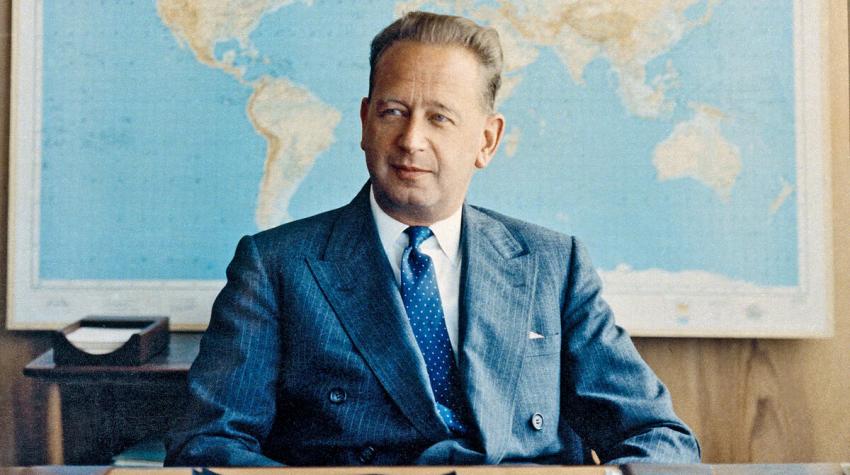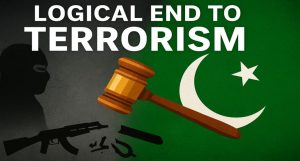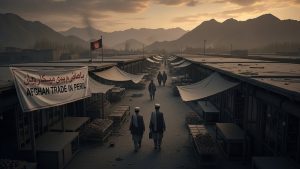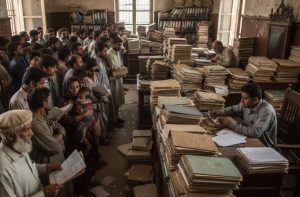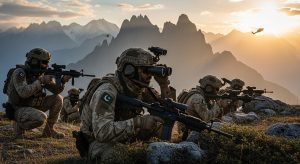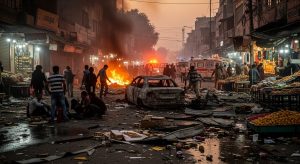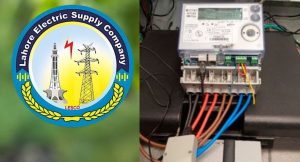“Daag Hammarskjold was on the verge of getting something done when they killed him. Note I said ‘When they killed him’.” –Harry S. Truman, ex-President of U.S., to reporters of New York Times, September 20, 1961
The death of the most independent and charismatic U.N. Secretary General ever, Daag Hammarskjold of Sweden, remained a mystery for decades. Daag Hammarskjold was the second Secretary General of the U.N. and held the position from 1953 until his death in a mysterious plane crash in a forest near Ndola on September 18, 1961. Ndola, currently in Zambia, was then part of the British protectorate of Rhodesia.
Suspicions of foul play in the crash abounded and have never died down. The enigmatic remarks of President Truman quoted in the New York Times two day later, indicate that he knew of foul play in Hammarskjold’s death. He used the phrase “they killed him”. It was Harry S. Truman who, as President, had created the CIA through the National Security Act of 1947.
The British Central African Federation, headed by Sir Roy Welensky, comprised of Northern Rhodesia, Southern Rhodesia, and Nyasaland – currently Zambia, Zimbabwe and Malawi. Welensky’s own views about the U.N. role in the then Katanga conflict in Congo were highly unfavorable towards the U.N. All Rhodesian investigations into the crash were conducted under Welensky’s government. Welensky was blamed for the death of Hammarskjold and became a hated symbol of colonialism throughout the Afro-Asian world. Welensky’s mother was an Afrikaan and his father a Lithuanian Jew.
Hammarskjold had gone to the region to resolve a conflict in Congo. Katanga the mineral rich part of Congo had suddenly seceded under MoiseTshombe. Tshombe had accused the central government of communist leanings and of dictatorial policies. Congo was then headed by a popular leader named Patrice Lumumba, an African nationalist, and a pan-Africanist. Lumumba had appealed to the UN to prevent the breakup of Congo. Congo had become independent in 1960 and as a result of an election in May 1960, Lumumba became Prime Minister.
As a result of Lumumba’s request Hammarskjold called a meeting of representatives of African countries on July 12, 1960 and then on the 14th of July the Security Council passed a resolution calling upon Belgium to withdraw its forces from Congo and also called upon the U.N. to send forces to help stabilize Congo until the Congolese government was able to develop its own forces. A 3,500 strong contingent from countries which had no interest in the Congo was sent within days of the resolution indicating Hammarskjold’s interest in saving Congo’s fledgling democracy.
Katanga was of vital importance to the West as it was rich in copper, uranium, cobalt (which is crucial for the aircraft industry), and so on. Soon after the announcement of Katangan independence, the Belgian mining company, Union Miniere, began paying its taxes to Katanga instead of the central government. These amounted to about 70% of Katanga’s budget and enabled Tshombe to maintain a military force. The Belgians had provided a 7,000 strong military force, along with “advisors”, supplemented by white mercenaries from Belgium, Britain and South Africa.
On August 9, 1960, the diamond rich province of South Kasai declared independence under a nominal leader named Albert Kalonji. This further deepened the crisis. At the time the Belgian troops were still in the country and here too, a Belgian company named Forminiere, played a role similar to Union Miniere. The central government was being deprived of revenues from its richest regions. Lumumba seemed to have lost hope in the ability of the U.N. to save Congo. He therefore requested the Soviet Union on August 15 for military help.
Hearing of the arrival of the Soviets in Congo Allen Dulles sent an urgent telegram to the CIA station head in Congo, Larry Devlin, directing that the “removal [of Lumumba] must be an urgent and prime objective … this should be a high priority of our covert action.” The order of eliminating Lumumba had been approved by President Eisenhower. The CIA had entered the field and, as had now become its practice, wished to arrange the assassination of a most popular and elected leader.
Susan Williams writes: “Just two months after the independence of Congo, on 5 September, there was a new, dramatic development, facilitated by the CIA in Leopoldville. On the urging of Larry Devlin and with the support of Daphne Park, an MI6 official in Leopoldville, President Kasavubu dismissed Lumumba and six other ministers – members of democratically elected government. Kasavubu’s order was firmly condemned by a joint meeting of the Congo’s upper and lower Houses of Parliament, which accorded full powers to the government of Lumumba.”
CIA, however, was unrelenting. On 14 September, under the direction of the CIA, Kasavubu dissolved the Parliament. And on that very evening a 29-year old colonel, a CIA asset, named Desire Mobutu took over military control of the country. That was the end of Congo’s democracy. It had, on account of its mineral wealth, become a proxy battleground. And the U.N, was caught in the midst of it all. Then, in January 1961, Lumumba and two other ministers were killed. The whole world knew immediately that this was a CIA assassination. Proof of it is now available because of what Dulles had stated in his telegram to Larry Devin.
The urgency in getting rid of Lumumba also arose from the imminent change in the White House. James W. Douglas has written in his outstanding book JFK and the Unspeakable: “The CIA took seriously Kennedy’s African nationalist sympathies. As his inauguration approached, the CIA’s station chief in Leopoldville, Lawrence Devlin, spoke of ‘the need to take “drastic steps” before it was too late.’ CIA analyst Paul Sakawa pointed out in an interview that the decision to put Lumumba in the hands of his assassins was made by men ‘in the pay of and receiving constant counsel from the CIA station.’ The CIA succeeded in having Lumumba killed in haste by Belgian collaborators three days before Kennedy took oath of office.” Kennedy learned of Lumumba’s assassination on February 13, 1961 and was “horror-stricken”. Little did he know that he too would fall prey to CIA’s bloodlust almost three years later!
The outcry against the assassination of Lumumba was worldwide and the U.N. was under pressure for having failed to protect him. Hammarskjold had met Lumumba shortly before Lumumba’s assassination. The U.N. had launched Operation Morthor on September 13, 1961 to bring Katanga back to the Congolese fold. The U.N. intended to police the region and the 15,000 strong U.N. force comprised military men from eighteen countries which had no interest in Congo. The British government then urged Welensky, Prime Minister of the British Central African Republic, on September 13, to send Rhodesian troops and air force in the vicinity of the border. The Western powers had no intention of allowing the U.N. to enforce its principled decisions in regions that were of interest to them. Hammarskjold had gone to the region to meet Tshombe, who was supported by Belgian, British and South African mercenaries, so as to effect a cease-fire.
In the year 1998 certain documents appear to have been found, apparently accidentally, in a file in South Africa that seemed to open a door to investigations by researchers into the death of Hammarskjold. Christelle Terreblanche, who was working for the Truth and Reconciliation Commission (TRC) of South Africa was given a file pertaining to the 1993 assassination of Chris Hani, head of the South African Communist Party.
In the file that Terreblanche took home, were about 12 pages related to something called Operation Celeste. This operation was not related to the assassination of Hani but to the assassination of Daag Hammarskjold. The operation involved blowing up the plane carrying Daag Hammarskjold by planting a bomb on it. The documents involved MI5, Special Operations Executive (which apparently had been disbanded after WWII) and mentioned that Allen Dulles of CIA had assured full cooperation. The documents, some handwritten, some typed carried the name of an organization called South African Institute of Maritime Research (SAIMR). According to the documents Operation Celeste did not go as planned because the bomb was to blow off at the time of take-off but instead blew up on landing.
Terreblanche thought over the matter quite intensely because she was used to finding disinformation in the files. But she felt that it was a matter of great importance and that the matter needed a proper investigation. She tried to argue with her superiors but was not successful because they were in July 1998 and the TRC report had to be filed with President Nelson Mandela by October 1998.
Terreblanche had had a terrible experience which seemed to involve SAIMR although she had not earlier ever heard of it. In her files a human rights claim had turned up by default. The daughter of a woman had been working on AIDs research in Mozambique for the SAIMR! She had found out that SAIMR had been smuggling contaminated vaccines into Angola and Mozambique. The daughter was planning to come and tell her mother about it when she was killed in a car hijacking incident in Johannesburg. The death could not be accidental. If SAIMR was connected with the MI5 and the CIA, as indicated in the Operation Celeste documents, then the girl might have been killed to prevent her from revealing the matter of contaminated vaccines being smuggled into Africa by SAIMR, to her mother in detail. In fact, the brother of the murdered lady told the Danish director Mads Brugger (who produced a documentary on Hammarskjold) that she had predicted that she would be killed! That indicates that she was aware of that SAIMR was indeed a lethal organization. But nobody had heard of it.
On August 19, 1998, Bishop Desmond Tutu revealed the existence of documents pertaining to Operation Celeste. He released copies of eight out the twelve pages. All names had been redacted because TRC rules required that the concerned persons be contacted prior to release of their names. Tutu explained that the Celeste documents had been handed over to the Minister of Justice Dullah Omar who, at the time, had not had the time to look at the documents and did not, therefore, comment. Desmond Tutu also pointed out that the mandate of TRC was running out and TRC was, therefore, not in a position to investigate the authenticity of the documents. However, he did not rule out such an investigation in view of the serious content of the documents.
Bishop Desmond Tutu’s revelations got worldwide attention. In the Belgian Senate a demand for a proper investigation was raised but it was not taken up. The British Foreign Office expectedly denied any involvement of the British government in the assassination. The CIA, as always, denied any involvement. An investigation by the Rhodesian authorities laid the blame on pilot error.
But the matter was not so simple. One man who survived the crash and died six days later, revealed that the plane was already in flames before crashing. Eye witnesses also reported that the plane was in flames while in the air. Witnesses also reported seeing another plane that flew away after the crash. They also reported that after the plane crashed, the lights of the airport went dim. The notes of the air traffic controller were lost and were reconstructed two days later. All bodies of those dead were charred beyond recognition except that of Hammarskjold. A photograph showed a playing card stuffed into Hammarskjold ruffled tie. According to a witness the card was an ace of spades. The plane was discovered at 3;00 p.m., almost 15 hours later, whereas it crashed around midnight and witnesses had reported it early on.
In 2000, a Norwegian historian had obtained copies of the SAIMR documents from the TRC records, through his country’s ambassador in Pretoria. The CEO of TRC faxed copies eight of the twelve pages to the ambassador on 29th May, 2000, apologizing for their poor quality, and stating that the originals had been sent to the National Intelligence Agency. Susan Williams has pointed out that the originals seem to have disappeared. Searches made in collaboration with relevant South African institutions and officers failed to produce the documents.
In her book Who Killed Daag Hammarskjold? Susan Williams has looked into the possibility that these documents could be disinformation. But there are so many things about them that ring true despite some questions that arise. One document, entitled “ORDERS” has been reproduced by Susan Williams. It refers to a meeting between MI5, Special Ops and SAIMR. It starts by stating that” Dag” [i.e. Hammarskjold] has requested that blockbusters be shipped to Katanga via Rhodesia and South Africa, and that Dr. V [Hendrick Verwoerd, PM of SA] and Sir Roy [Welensky] have refused. The document then goes on: “UNO is becoming troublesome and it is felt that Dag Hammarskjold should be removed. Allen Dulles agrees and has promised full cooperation from his people. [He] tells us that Dag will be in Leopoldville on or about 12/9/61. The aircraft ferrying him will be a D.C. 6 in the livery of ‘TRANSAIR,’ a Swedish Company.”
The next part of the said document contains orders to eliminate Daag Hammarskjold: “Please see that Leo airport as well as Elizabethville is covered by your people as I want his removal to be handled more efficiently than was Patrice [Lumumba]. If time permits, send me a brief plan of action, otherwise proceed in all speed in absolute secrecy. If McKeown and O’Brein can be dealt with simultaneously it would be useful but not if it could compromise the main operation. If, and only if serious complications arise tell your agents to use telephone [illegible’ Johannesburg 25-3512. Operation to be known as Operation Celeste.” Lt. Gen. Sean McKeown was from Ireland and headed the UNO forces. Connor Cruise O’Brein was an official of the UNO.
In a communication from a “Commandant” it is suggested. to focus only on Daag Hammarskjold. It also states: “Dag will be sorted out on the 17th or 18th “ (he has an appointment in Ndola on the 18th or 19th) all my men as well as Congo Red’s people are in In position.” The SAIMR documents contain a document entitled Report Operation Celeste dated 18.9.61. The operation involved pacing a six pound TNT bomb in the carriage of the plane which would explode when the wheels of the pane were retracted after take-off.
A document dated 18.1.61 and entitled “Report Operation Celeste” states: “1. Device failed on take-off. 2. Despatched Eagle [illegible word] to follow and take [illegible words] 3. Device activated [illegible words] prior to landing. 4. As advised McKeown and O’Brein were not on board. 5. Mission accomplished satisfactory. Message Ends”.
An American intelligence officer named Charles Southall was posted in Nicosia, Cyprus, at the time of the Daag Hammarskjold’s plane crash. He worked for the NSA. The NSA had a listening post in Cyprus, which was located in a huge hall, with equipment and about one hundred desks, just outside Nicosia. Southall was in charge of a team that processed incoming messages. If possible they decrypted them, or translated them and sent the reports to Washington, along with relevant information about their source and time, etc. Southall revealed something about the Hammarskjold assassination, which he also confirmed in an interview with Susan Williams.
About three hours before midnight on September 17, 1961, he got a call from the Communications Watch Officer: “Hey! Get yourself out here tonight! Something interesting is going to happen.” So some of the NSA people were aware of an impending assassination. Intrigued, Southall changed and drove over. About four or five people clustered around a loudspeaker and heard a recording that was about seven or eight minutes old. The time was shortly after midnight. They could hear the noise of an engine and the voice of a pilot who was stating what he was seeing and doing. “I see a transport plane coming low. All the lights are on. I’m going down to make a run on it. Yes it is the Transair DC6. It’s the plane.” Then they heard the gun cannons firing. The pilot then exclaimed: “I’ve hit it. There are flames. It’s going down. It’s crashing.” Charles Southall’s revelation confirms what witnesses saw and reported viz. there was another plane, and the DC6 was in flames while in the air.
From the documents, and from an assessment of the situation, it is clear that Western powers wished to eliminate Daag Hammarskjold. The elimination of Daag Hammarskjold did not, and could not have had the approval of President Kennedy. So why did Allen Dulles, who was to leave as Director Central Intelligence at the end of 1961, give a go ahead for the assassination of Daag Hammarskjold? In doing so Dulles was doing something over and above the head of his president. Dulles had been “removed”, by a premature termination of his tenure, by John Kennedy for having lied to him in regard to the Bay of Pigs operation.
This question of why Dulles wished that Hammarskjold be assassinated, has finally been answered by Dr. Greg Poulgrain in his 2020 book JFK vs. Allen Dulles: Battleground Indonesia. A dispute was going on in the Far East at the time regarding the ownership of the Netherlands New Guinea area (also called Papua). The dispute involved Netherlands, a NATO member and Indonesia, an emerging developing country. What was known to a tiny circle of the Dutch government, and to Allen Dulles, but was not known to Sukarno, was the quiet discovery of huge gold deposits in the dense mountains of Netherlands New Guinea in 1936. The discovery was made by, what was thought to be a Dutch company, NNGPM (it is an acronym of a Dutch name). It was not known that the Rockefellers had 60% ownership of company and Allen Dulles, as their legal representative, had helped set up NNGPM in 1935. So Dulles knew of the immense gold wealth of the region.
In the words of Poulgrain: “In the alpine regions of Neterlands New Guinea in 1936, three Dutchmen discovered a mountainous outcrop of ore with high copper content and very high concentrations of gold. When later analyzed in Netherlands, the gold (in grams per ton) proved to be twice that of Witwatersrand in in South Africa, then the world’s richest goldmine, but this information was not made public. If the real concentration of the gold discovery had been announced, Dutch sovereignty of the remote territory would have become even more precarious than the slim hold it had, with only a few hundred Dutch people living there.”
In view of this the results of geological analysis of the place (Erstberg mountain) were hugely falsified in geological publications in 1939. Poulgarin writes: “Written incorrectly in the summary of the results, the gold concentration was stated to be only one-fifteenth of the actual gold concentration, and this created the false impression that the Erstberg was not worth consideration as a gold mine.”
Dulles was a 32nd degree Freemason and was a loyal dog of the Rockefellers. He wanted his masters, the Rockefellers, to own that gold. At the time the CIA had not been established. When Dulles became Director CIA he did not reveal the existence of the gold to either Eisenhower or JFK. He knew that under Sukarno the Rockefellers could never own the Erstburg gold. He therefore pursued his own secret policy in Indonesia. As a first step he wished that Sukarno be eliminated. The CIA organized assassination attempts but Sukarno survived, escaping so narrowly on one occasion, when his security in charge pushed him to the ground and covered him with his own body.
JFK wished to win over Indonesia but had the problem that if he preferred Indonesia over a NATO ally it could be embarrassing. However, according to Poulgrain: “His [Hammarskjold’s] plan was to annul all claims of sovereignty other than the indigenous inhabitants and to announce this at the UN General Assembly in October/November 1961, but his death occurred in September 1961.” Daag Hammarskjold had worked out a solution for regions which were becoming independent but had no experience whatsoever in governance. That plan, called OPEX, would have led to an independent Netherlands New Guinea whose administration would, for a time be run by UN officials who would train the local populace, i.e. the Papuans, to administer their country.
Poulgrain writes: “Applying OPEX to the New Guinea dispute. Hammarskjold was threatening to take the territory out of the control of all aspiring colonial powers and out of the hands of Rockefeller Oil that had first staked its claim before World War II. The motive to prevent him from implementing OPEX in West New Guinea, quite apart from the Sino-Soviet bloc opposition, was immense.” As pointed out by authors the UN activities were “vigorously scrutinized by the CIA “in New York.
Dulles was, therefore, aware of what was going on with regard to OPEX and he knew that JFK supported Daag Hammarskjold’s initiative. Dulles also knew that once the OPEX plan was announced in the UN General Assembly, JFK would openly support it. And that was what he wished to stop at all costs. In the worlds of Poulgrain: “While Belgian and British interests were more directly tied to the Katanga dispute, Dulles was seen more as a Cold War participant and slightly removed from direct involvement. Dulles’ motive to stop Hammarskjold from interfering in the New Guinea dispute was far greater than any apparent motive in Congo. He was so far ahead of his contemporaries they did not suspect him of pushing a button, or causing a death, on one side of the world to benefit a covert strategy of his on the other side of the world.”
In a separate article it will be described how Dulles, and then his man Richard Helms as Director CIA, precipitated a civil war in Indonesia and eventually managed to get hold of the Erstburg gold for a company in which the Rockefellers had an important share. The timing of the JFK assassination was also tied up with the Netherlands New Guinea gold. JFK was to visit Indonesia in January 1964, and he was killed weeks before that visit, on November 23, 1963.Had JFK visited Indonesia Sukarno would have stayed on as a lifetime President, and the gold would never have gone the way Dulles desired.

